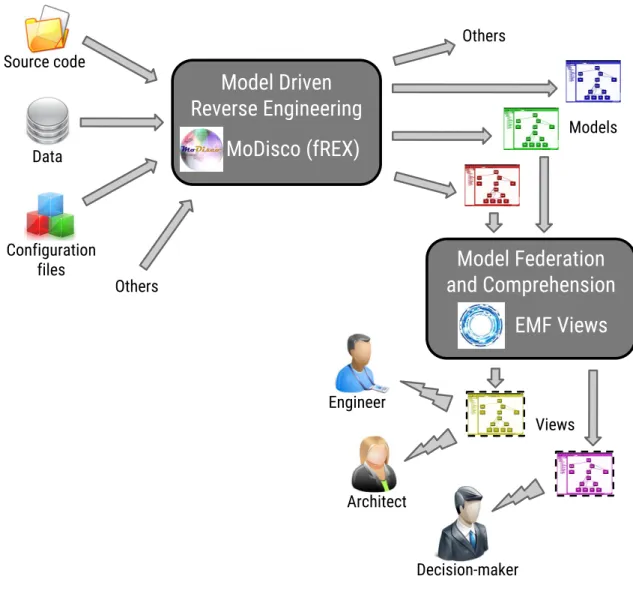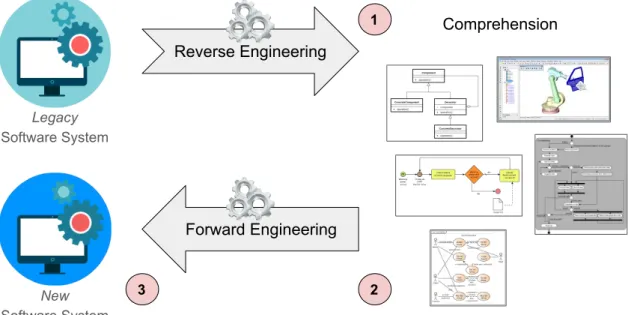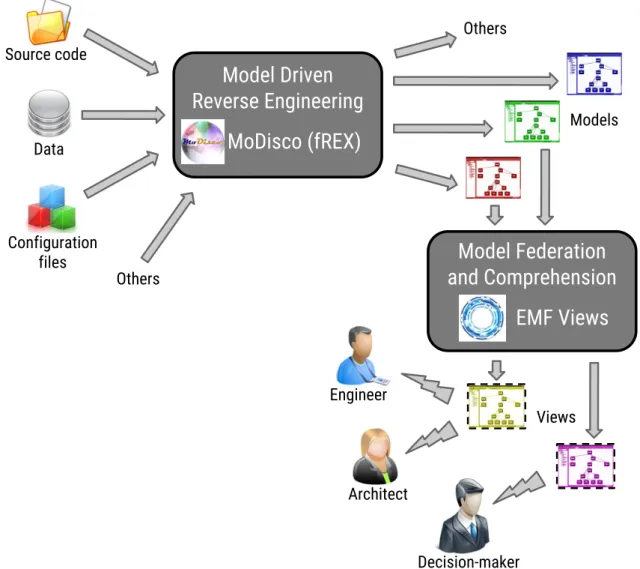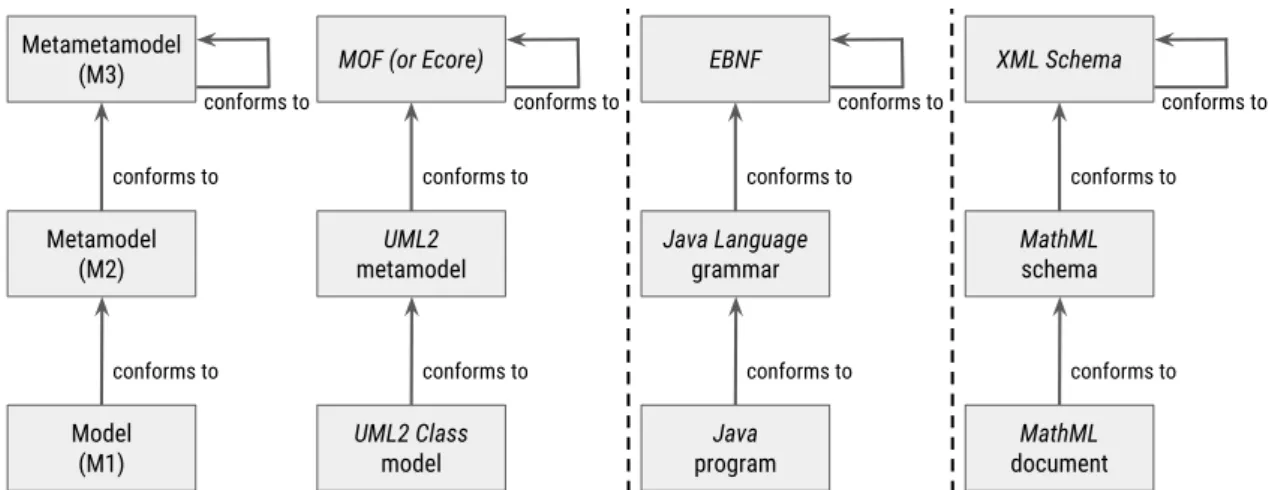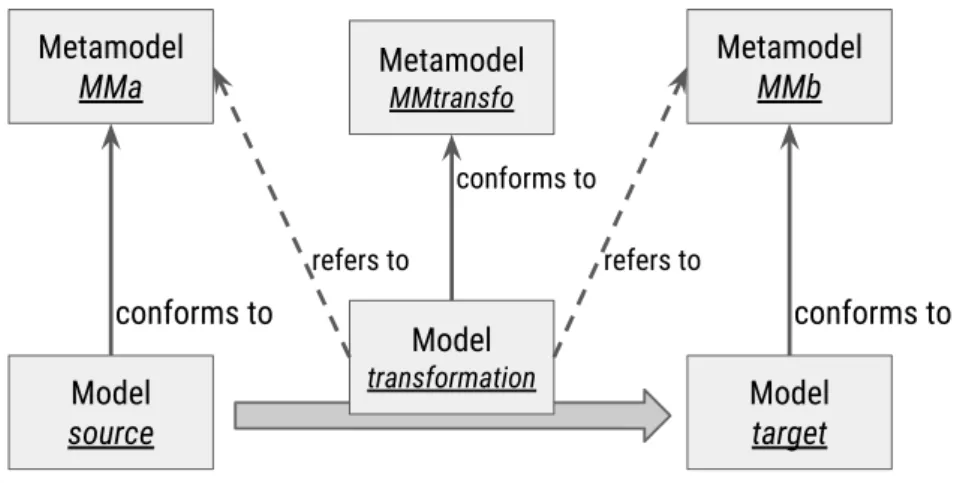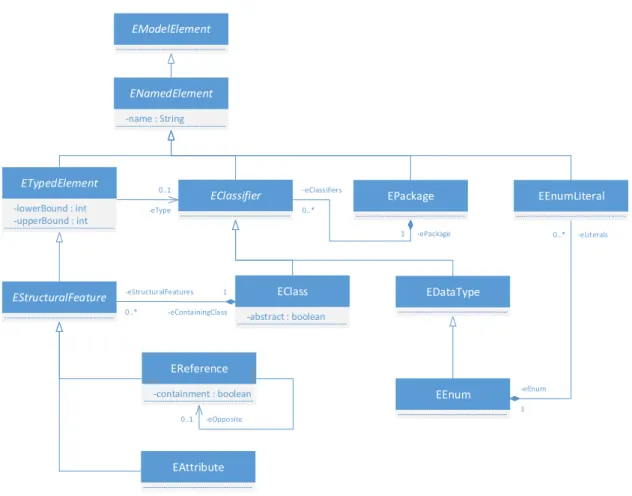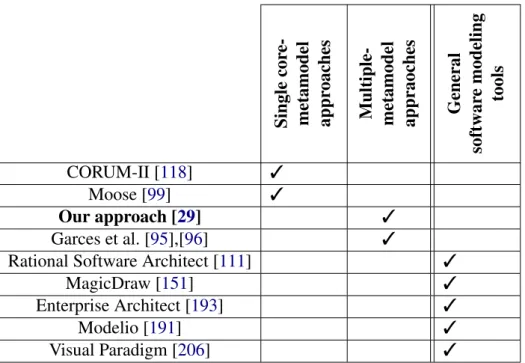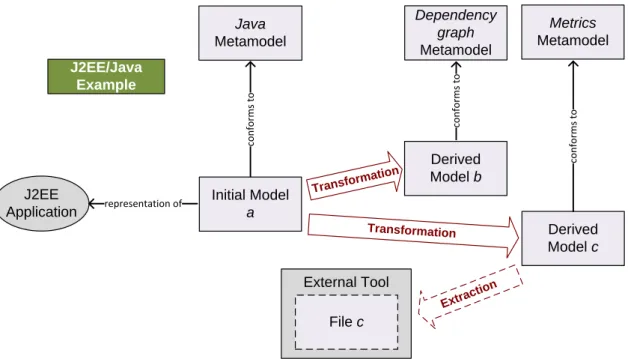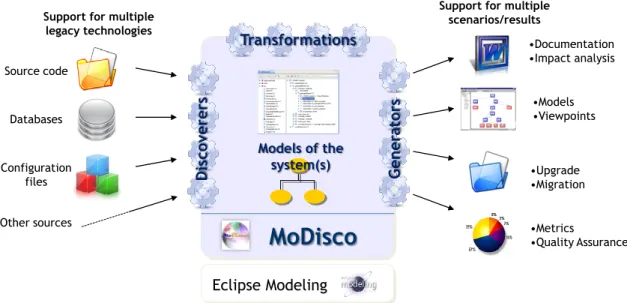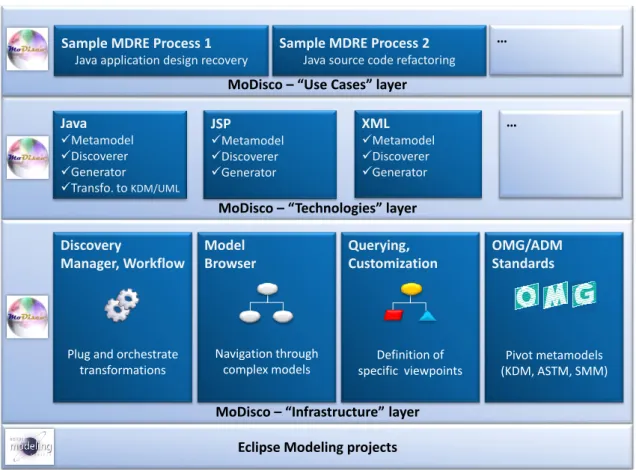HAL Id: tel-02106854
https://tel.archives-ouvertes.fr/tel-02106854
Submitted on 23 Apr 2019HAL is a multi-disciplinary open access
archive for the deposit and dissemination of sci-entific research documents, whether they are pub-lished or not. The documents may come from teaching and research institutions in France or abroad, or from public or private research centers.
L’archive ouverte pluridisciplinaire HAL, est destinée au dépôt et à la diffusion de documents scientifiques de niveau recherche, publiés ou non, émanant des établissements d’enseignement et de recherche français ou étrangers, des laboratoires publics ou privés.
Engineering and Comprehension
Hugo Bruneliere
To cite this version:
Hugo Bruneliere. Generic Model-based Approaches for Software Reverse Engineering and Compre-hension. Software Engineering [cs.SE]. Université de Nantes, 2018. English. �NNT : 2018NANT4040�. �tel-02106854�
T
HESE DE DOCTORAT DE
L'UNIVERSITE
DE
NANTES
COMUE UNIVERSITE BRETAGNE LOIRE
ECOLE DOCTORALE N°601
Mathématiques et Sciences et Technologies de l'Information et de la Communication
Spécialité : Informatique
Generic Model-based Approaches for Software
Reverse Engineering and Comprehension
Thèse présentée et soutenue à Nantes le jeudi 20 décembre 2018
Unité de recherche : IMT Atlantique Bretagne-Pays de la Loire, Ecole Mines-Télécom
Laboratoire des Sciences du Numérique de Nantes – LS2N (CNRS, UMR 6004)
Par
Hugo BRUNELIERE
Rapporteurs avant soutenance :
Richard Paige Professeur – University of York, York (United Kingdom)
Benoit Baudry Professeur – KTH Royal Institute of Technology, Stockholm (Sweden)
Composition du Jury :
Président : Jordi Cabot Professeur – ICREA & Open University of Catalonia, Barcelona (Spain) Examinateurs : Richard Paige Professeur – University of York, York (United Kingdom)
Benoit Baudry Professeur – KTH Royal Institute of Technology, Stockholm (Sweden) Corinne Miral Maître de conférences HDR – Université de Nantes, Nantes (France) Référent : Gerson Sunye Maître de conférences HDR – Université de Nantes, Nantes (France)
Note :
Les travaux scientifiques présentés dans ce manuscrit de thèse ont été réalisés sous la supervision du Professeur Jordi Cabot, également membre du jury.
Foremost, I would like to express my sincere gratitude to Dr. Gerson Sunye and Prof. Jordi Cabot for their precious advices and feedback when writing down this Ph.D. thesis manuscript that summarizes a significant part of my professional life. This has been quite a constructive experience for me. I also would like to thank Prof. Jordi Cabot for mentoring me during his years in Nantes, and I hope we can continue having more good collaborations in the future.
Besides them, I would like to thank Prof. Richard Paige and Prof. Benoit Baudry for reviewing the present manuscript and providing their insightful comments on this work. In addition, I would like to thank Dr. Corinne Miral for also taking part in my thesis committee.
I thank all the so-called AtlanMod & Friends (and now NaoMod folks) for the stimu-lating, international and fun working environment in which I have the chance to evolve since more than 12 years. Notably, I would like to give extra thanks to the project engi-neers that did a great job on the implementation of MoDisco & EMF Views: people from Mia-Software (Frédéric Madiot, Grégoire Dupé, Fabien Giquel and others), Guillaume Doux, Juan David Villa Calle, Jokin García Pérez and Florent Marchand de Kerchove.
More generally, I thank everyone I had the chance to meet, discuss and work with all along these years in the context of various projects or conferences/events, here in Nantes or elsewhere in Europe and the rest of the world. It has been a long enriching journey!
Last but not least, I would like to give very special thanks to Prof. Jean Bézivin for convincing me to work in a research environment in the first place. I am grateful for this great opportunity he offered me back then.
To my wife and little boy To my parents and younger sister To my entire family, and to the new Brazilian one To my other family: friends from my hometown, from here and elsewhere
Introduction
Avec l’avènement des technologies de l’information dans notre société, les organi-sations entreprennent de plus en plus de projets de migration et/ou de modernisation lo-giciel. De nombreuses entreprises, indépendamment de leur taille et secteur d’activité, font désormais face au problème bien connu de devoir gérer, maintenir, faire évoluer ou remplacer leurs systèmes logiciel existants [135]. Une telle situation est principalement due aux fréquentes et rapides modifications dans le paysage technologique. Cependant, les raisons sont généralement multiples: nouveaux besoins utilisateurs, stratégies métiers en évolution, aspects organisationnels en mouvement, législations changeantes, etc. Dans tous les cas, la motivation principale derrière les projets de migration/modernisation est habituellement économique [130].
En raison de cela, les entreprises sont régulièrement poussées à faire évoluer (au moins en partie) leurs systèmes logiciel déjà existants avant que ceux-ci ne deviennent véritablement obsolètes ou ne commencent à dysfonctionner. Ces systèmes patrimo-niaux sont souvent de grandes applications jouant un rôle critique au sein du système d’information de l’entreprise [15]. De plus, ils ont habituellement un impact non-négli-geable sur son fonctionnement au quotidien.
Les projets de migration/modernisation associés ne peuvent donc pas être pris à la légère, puisqu’ils ne viennent jamais sans d’importants challenges associés [122]. Dans le cas idéal, ils ne devraient pas débuter en raison de modes passagères mais plutôt car fortement motivés par de réels limitations technologiques ou en anticipation de problè-mes à venir. Cependant, en pratique, les décideurs et ingénieurs ont seulement une vision limitée et partielle de la complexité et des potentielles conséquences de leurs projets lo-giciel [80]. Ainsi, améliorer la compréhension globale des systèmes logiciel concernés (e.g. en termes d’architecture, de fonctionnalités fournies, de règles métierimposées ou de données manipulées) est un point crucial [208].
L’Ingénierie Dirigée par les Modèles (IDM) [182], souvent plus généralement ap-pelée Modélisation, est un paradigme du Génie Logiciel reposant sur la création, la ma-nipulation et l’utilisation intensive de modèles de natures diverses et variées. Elle repose largement sur l’hypothèse de base que tout est un modèle [19]. Ces modèles peuvent décrire différents (et possiblement tous les) aspects complémentaires à la fois des systè-mes modélisés et des activités d’ingénierie associées. Par conséquent, dans les approches basées sur les modèles, ceux-ci sont considérés comme des entités de première classe au sein des processus de conception, développement, déploiement, maintenance et évo-lution. La communauté scientifique de l’IDM est soutenue par un écosystème solide et
riche en pratiques, outils et cas d’utilisation provenant à la fois des mondes académique et industriel [24]. Des études relativement récentes sur l’application concrète de l’IDM dans l’industrie [110, 210] ont montré que l’IDM a déjà engendré des bénéfices intéréssants dans le cadre de différents types de projets ou d’activités à forte composante logiciel.
Description de la Problématique
Un projet de migration et/ou modernisation est habituellement constitué de trois pha-ses consécutives distinctes :
1. Le processus complexe d’obtention de représentations utiles et de plus haut niveau d’un système (patrimonial) donné est appelé rétro-ingénierie [43]. Son objectif ultime est de fournir une meilleure compréhension du but et de l’état actuel du système concerné.
2. L’ingénierie avancée analyse ensuite ces modèles et les transforment (lorsque né-cessaire) en des spécifications de la nouvelle version du système [14].
3. Les développeurs ou des techniques de génération automatique de code (ou une combinaison des deux) utilisent finalement ces modèles pour produire le code correspondant à la plateforme ciblée [107].
Des assemblages de différentes solutions et technologies peuvent aider à la réalisation de quelques unes des tâches nécessaires. Par exemple, c’est le cas d’outils qui produisent automatiquement différents types de modèles à partir de code source logiciel déjà exis-tant. C’est aussi le cas de générateurs de code ciblant divers langages de programmation et plateformes techniques. Cependant, à notre connaissance, il n’existe pas actuellement de méthodologie globale qui permette de guider les décideurs, les architectes logiciel et les ingénieurs tout au long d’un processus de migration/modernisation.
Ceci est particulièrement vrai dans le contexte de la phase de rétro-ingénierie, qui constitue le focus du travail présenté dans cette thèse. Les challenges importants asso-ciés [38] incluent notamment :
— Le support générique à des technologies logiciel hétérogènes (e.g. différents langa-ges de programmation).
— L’aptitude à extraire des données utiles à partir du système (e.g. allant plus loin que l’arbre de syntaxe abstraite).
— La couverture à la fois des dimensions statiques et dynamiques du système (e.g. in-cluant les données d’exécution).
— La capacité à obtenir des vues pertinentes du système et à gérer des liens de tra-cabilité entre elles.
Ce dernier point est même considéré comme une activité et un objectif fondamental de la rétro-ingénierie et compréhension du logiciel.
Assez récemment (comparé à l’histoire de la rétro-ingénierie), la Rétro-Ingénierie Di-rigée par les Modèles (RIDM) [181] a été proposée afin d’améliorer les processus de rétro-ingénierie plus traditionnels. La RIDM peut être définie comme l’application des principes et techniques de l’IDM dans le contexte d’activités de rétro-ingénierie. Les approches RIDM dépendent notamment des techniques basées sur les modèles existan-tes pour obtenir des modèles représentant les systèmes étudiés en fonction de différents aspects et à différents niveaux d’abstraction. Les diagrammes de classe UML (Unified
Modeling Languages) [167], les machines à états ou les workflows sont des exemples bien-connus de tels modèles (pour en citer seulement quelques uns).
En s’appuyant sur ces différents modèles obtenus, il est ensuite possible d’analyser plus en profondeur et de comprendre le système faisant l’objet d’un processus de rétro-ingénierie. Dans ce but, les résultats attendus incluent la fourniture de vues (basées sur ces modèles) cohérentes et complémentaires décrivant ce système [27]. De telles vues sur des modèles permettent de fédérer l’information pertinente provenant de divers modèles souvent interdépendants, notamment ceux précedemment obtenu par RIDM. Ces vues doivent être spécifiées et calculées en fonction de points de vue qui sont appropriés aux différentes parties prenantes.
Cependant, une limitation importante des approches RIDM existantes ainsi que des approaches de fédération/vue sur des modèles est qu’elles reposent assez souvent sur des intégrations sur-mesure et spécifiques de différents outils [201]. De plus, leurs implé-mentations techniques peuvent parfois s’avérer (très) hétérogènes et coûteuses. Cela peut compliquer encore davantage la situation, et peut à terme entraver leurs bons déploie-ments et utilisations pratiques.
Dans cette thèse, nous argumentons que des solutions génériques et extensibles com-plémentaires sont toujours manquantes (ou tout du moins fournissent un support incom-plet) afin d’être en mesure de combiner la RIDM avec des capacités avancées de fédéra-tion/vue sur les modèles. Plus particulièrement, de telles solutions doivent permettre d’adresser plusieurs types de scenarios de rétro-ingénierie et compréhension du logiciel, s’appuyant possiblement sur différentes plateformes techniques. De plus, fournir des im-plémentations en logiciel libre des approches proposées doit permettre de favoriser leur intéropérabilité avec l’existant ainsi que leur dissémination à plus large échelle.
Approche Mise en Oeuvre
L’objectif de cette thèse est donc de progresser vers l’amélioration du support réu-tilisable pour des cas d’utilisation possiblement hétérogènes de rétro-ingénierie et préhension du logiciel. Notre proposition est de s’appuyer sur deux approches com-plémentaires, génériques, extensibles et basées sur les modèles dans le but de faciliter l’élaboration de solutions à ce problème.
Rétro-Ingénierie Dirigée par les Modèles (RIDM). Nous avons commencé par ca-pitaliser à la fois sur les différentes pratiques existantes (provenant de l’état de l’art) et sur nos propres expériences passées (e.g. de collaboration avec des entreprises dans le contexte de vrais projets de modernisation). À partir de cette connaissance scientifique et pratique acquise au fil des ans, nous avons été en mesure de spécifier un processus global ainsi qu’une architecture support pour une approche de RIDM générique et extensible. Nous avons également travaillé sur une implémentation concrète de cette approche con-ceptuelle sous la forme d’un premier framework en logiciel libre, en partenariat direct avec une entreprise experte du domaine. Initialement, la solution conçue se focalisait principalement sur la rétro-ingénierie des aspects structurels (i.e. statiques) des systèmes logiciel. Nous avons par la suite complété ce framework avec des travaux de recherche supplémentaires sur la rétro-ingénierie d’aspects comportementaux (i.e. dynamiques).
Compréhension via Fédération/Vue sur des Modèles. De manière complémentaire à la RIDM, des capacités de fédération de modèles sont attendues afin d’améliorer les activités de compréhension (basée sur les modèles) du logiciel. Ainsi, nous avons pro-posé une approche générique (i.e. indépendante des types de modèles concernés) pour la construction et la manipulation transparente de vues sur des modèles. De telles vues peuvent possiblement fédérer divers ensembles de modèles hétérogènes, en fonction de différents points de vue exprimant les aspects à partir desquels le système concerné doit être observé. Basé sur la notion de virtualisation de modèles, nous avons dévelopé une implémentation non-intrusive de cette approche conceptuelle. Il en a résulté un second framework en logiciel libre, qui peut notamment consommer des modèles produits par notre premier framework dédié à la RIDM (parmi d’autres modèles provenant de diffé-rentes sources).
S’appuyant toutes les deux sur les mêmes principes et techniques de base de l’IDM, les deux approches conceptuelles proposées peuvent être combinées et chaînées ensem-ble de manière naturelle. L’intégration pratique des deux frameworks correspondants est rendue possible grâce à l’utilisation d’un environnement de modélisation commun et par-tagé. Basées sur ces deux approches et frameworks, des solutions plus élaborées de rétro-ingénierie et de compréhension du logiciel peuvent être conçues dans le but d’adresser des scénarios potentiellement complexes. De plus, les approches proposées peuvent éga-lement être réutilisées (de manière indépendante ou conjointe) en collaboration avec des approaches basées sur les modèles adressant d’autres problématiques, toujours dans un contexte de Génie Logiciel ou bien associé à d’autres types d’activités.
Contributions
Comme représenté graphiquement dans la Figure 1, les contributions principales de cette thèse sont les suivantes :
— MODISCOpropose une approche de RIDM globale, générique et extensible ayant pour objectif de faciliter l’élaboration de solutions de RIDM dans de nombreux contextes différents. Elle est réalisée en pratique par un framework technique étant un projet officiel Eclipse construit au dessus de l’environnement Eclipse et son Eclipse Modeling Framework (EMF). Parmi d’autres possible sorties (e.g. code source généré, rétro-documentation), ce framework permet notamment d’obtenir différents types de modèles à partir de systèmes existants et des divers éléments qui les composent (code source, données, etc. ). Les modèles obtenus peuvent ensuite être réutilisés lors des activités de fédération et compréhension, e.g. en utilisant EMF VIEWStel qu’introduit juste après.
— FREX propose un framework ouvert et extensible, basé sur l’approche MO -DISCO , qui est capable de générer automatiquement et d’exécuter des mo-dèles comportementaux exprimés en fUML (Foundational UML Subset). Il fournit également un mapping de base initial entre les diagrammes de clas-ses/activités d’UML (i.e. fUML) et des éléments noyaux du langage de pro-grammation Java.
— EMF VIEWS propose une approche générique et extensible ayant pour objectif de spécifier, construire et manipuler des vues sur des ensembles de modèles exis-tants divers et variés. Ces vues peuvent être pertinentes pour différents types de
parties prenantes (e.g. ingénieurs et architectes logiciel, décideurs). La solution proposée peut notamment consommer les modèles produits précédemment grâce à MODISCO, mais peut également réutiliser des modèles provenant d’autres sour-ces (e.g. définis manuellement par des ingénieurs). Elle repose sur un backend de virtualisation de modèles qui permet de renvoyer au contenu de tels modèles de manière transparente et non-intrusive. Elle est également réalisée en pratique par un framework dédié implémenté au dessus de l’environnement Eclipse/EMF. — En complément de l’approche EMF VIEWSet de son framework
d’implémen-tation, nous contribuons une étude détaillée de l’état-de-l’art sur les approches de vue sur des modèles. Grâce à ce travail étendu, un feature model est proposé afin d’aider à caractériser les différentes solutions disponibles et à sélectionner la/les plus appropriée(s) dans des contextes donnés.
Model Driven
Reverse Engineering
MoDisco (fREX)
Model Federation
and Comprehension
EMF Views
Source code Data Configuration files Models Others Views Decision-maker Architect Engineer OthersFigure 1 – Un écosystème basé sur les modèles pour la rétro-ingénierie et compréhension des systèmes logiciel.
Outils et Résultats
Les approches et frameworks présentés dans cette thèse sont tous implémentés sous la forme de plugins Eclipse en logiciel libre. L’intégralité de leur code source, leur
do-cumentation ainsi que les différentes autres resources de développement et d’utilisation associées sont disponibles en ligne via des sites ou dépôts dédiés (MODISCO1, FREX2, EMF VIEWS3). Tous ces frameworks techniques implémentant les approches conceptu-elles proposées sont construits au-dessus d’EMF, l’environnement de modélisation stan-dard dans l’écosystème Eclipse, afin de favoriser leur interopérabilité avec d’autres solu-tions déjà existantes par ailleurs.
Dans cette thèse, nous évaluons notamment le passage à l’échelle de nos solutions dans le contexte de différents cas d’utilisation réels (i.e. provenant directement d’entre-prises partenaires) ou réalistes (i.e. simulant des besoins réels remontés par des entred’entre-prises partenaires). Par exemple, nous montrons en pratique que nous sommes en mesure de fa-ciliter de manière effective la création de solutions techniques répondant à des besoins de rétro-ingénierie variés (refonte d’applications existantes, qualité du logiciel). Nous mon-trons aussi comment nous rendons possible la fédération de divers modèles hétérogènes (dont certains provenant de la rétro-ingénierie) dans un contexte industriel nécessitant une solution de traçabilité entre conception et exécution d’un système.
En complément de ces applications concrètes et pratiques, nous réalisons des tests de performance poussés concernant plus spécifiquement certains des composants clés de nos solutions. Notamment, nous évaluons dans le détail les capacités de notre solution de RIDM (i.e. MODISCO ) en termes de découverte automatique de modèles à partir de code source Java. Nous testons également la scalabilité de notre solution de fédération/-vue (i.e. EMF VIEWS) sur des modèles très volumineux décrivant des aspects compor-tementaux (dynamiques) d’un système. Les résultats obtenus dans les deux cas montrent que les solutions proposées sont d’ores-et-déjà déployables et utilisables dans des projets industriels à moyenne échelle. Cependant il reste encore des challenges scientifiques à adresser, notamment en ce qui concerne la découverte automatique de modèles compor-tementaux ou bien la vérification/validation et la mise-à-jour de vues sur des modèles à grande échelle.
Enfin, l’ensemble du travail de recherche présenté dans cette thèse a été réalisé et ap-pliqué dans le cadre de plusieurs projets collaboratifs nationaux et européens impliquant à la fois des laboratoires académiques et des entreprises. De ces expériences passées et présentes, nous tirons des leçons pouvant intéresser toute personne engagée dans des activités de création, conception, développement et promotion d’approches et d’outils basés sur les modèles. De manière plus générale, certains des facteurs clés de réussite (ou d’échec) que nous identifions peuvent également s’avérer pertinents dans le contexte de n’importe quel projet logiciel.
1. https://www.eclipse.org/MoDisco
2. https://github.com/atlanmod/fREX
Nowadays, companies undertake more and more software migration and/or moderni-zation projects for different reasons (economical, business-related, organimoderni-zational, techni-cal, legal, etc. ). Independently of their size and activity, they all face the problem of managing, maintaining, evolving or replacing their existing software systems. The first phase of any project of this kind is called Reverse Engineering: the complex process of obtaining various representations of an existing system, with the main objective to pro-vide a better comprehension of its purpose and state.
Model Driven Engineering (MDE) / Modeling is a software engineering paradigm relying on intensive model creation, manipulation and use. These models can describe different complementary aspects of the modeled systems and related engineering activi-ties. Thus, in model-based approaches, models are considered as first-class entities in design, development, deployment, integration, maintenance and evolution tasks.
Model Driven Reverse Engineering (MDRE) has been proposed to enhance more tra-ditional reverse engineering processes. MDRE can be defined as the application of MDE in the context of reverse engineering activities, in order to obtain models representing an existing system according to various aspects. It is then possible to further comprehend this system via coherent views federating these different models.
However, existing MDRE and model view/federation solutions are limited as they quite often rely on custom or case-specific integrations of different tools. Moreover, they can sometimes be (very) heterogeneous which may hinder their practical deployments and usages. Generic and extensible solutions are still missing (or providing incomplete support) for MDRE to be combined with advanced model view/federation capabilities.
In this thesis, we propose to rely on two complementary model-based approaches: (i) A generic and extensible approach intending to facilitate the elaboration of MDRE so-lutions in many different contexts. It notably allows to obtain different kinds of models out of existing systems and the various artifacts composing them (e.g. source code, data). (ii) A generic and extensible approach intending to specify, build and manipulate views federating different existing models (e.g. the ones resulting from our MDRE approach). Such views can be relevant to different kinds of stakeholders (e.g. software engineers/ar-chitects, decision-makers) according to comprehension objectives.
The corresponding implementations are open source and rely on the Eclipse-EMF de-factostandard modeling framework. They have been designed, developed and evaluated within collaborative projects involving several companies and their realistic use cases.
1
Introduction and Context
1.1
Introduction
With the advent of Information Technology in our society, organizations undertake more and more software migration and/or modernization projects every day. Many com-panies, independently of their size and activity type, are now facing the well-known problem of managing, maintaining, evolving or replacing their existing software sys-tems [135]. Such a situation is principally due to frequent and rapid modifications in the technological landscape. However, the reasons are generally multiple: new user require-ments, evolving business strategies, moving organizational aspects, changing legislation, etc. In any case, the main rationale behind migration/modernization projects is usually economical [130].
Because of that, companies are regularly pushed to evolve (at least part of) their al-ready existing software systems before these systems actually become obsolete or start to malfunction. These legacy systems are often large applications playing a critical role in the information system of the company [15]. Moreover, they usually still have a non-negligible impact on its daily operations.
The related migration/modernization projects cannot be taken too lightly, as they ne-ver come without significant associated challenges [122]. In the ideal case, they should not start because of passing fads but rather because strongly motivated by real technologi-cal limitations or forthcoming system issues. However, in practice, decision-makers and engineers have only a limited and partial vision over the complexity and potential con-sequences of their software projects [80]. Thus, improving the overall comprehension of the concerned software systems (e.g. in terms of architecture, provided features, enforced rules or handled data) is a crucial point [208].
Model Driven Engineering (MDE) [182], often more generally referred to as Mo-deling, is a software engineering paradigm relying on the intensive creation,
tion and use of models having various and varied natures. It is largely based on the core assumption that everything is a model [19]. These models can describe different (and pos-sibly all) complementary aspects of both the modeled systems and the related engineer-ing activities. As a consequence, in model-based approaches, models are considered as first-class entities within design, development, deployment, integration, maintenance and evolution processes. The MDEscientific community is backed by a solid ecosystem of existing practices, tools and use cases coming both from academics and industrials [24]. Relatively recent studies on the practical application ofMDEto the industry [110, 210] have shown that it has already brought interesting benefits to different kinds of software-intensive projects and activities.
1.2
Problem Statement
A software migration and/or modernization project usually has three distinct and con-secutive phases, as shown in Figure1.1:
1. The complex process of obtaining useful higher-level representations of a given (legacy) system is called reverse engineering [43]. Its main final objective is to provide a better comprehension of the purpose and current state of the concerned system.
2. Forward engineering then analyzes those models and transforms them (when ne-cessary) into the specification of the new version of the system [14].
3. Developers or automated code generation techniques (or a combination of both) use these models to produce the corresponding code for the targeted platform [107].
Legacy Software System New Software System Reverse Engineering Forward Engineering Comprehension 1 2 3
Figure 1.1 – The three phases of a software modernization and/or migration project. Combinations of different existing solutions and technologies can help realizing some of the necessary tasks. For example, this is the case of tools that automatically produce different kinds of models from already existing software source code. This is also the case of code generators targeting various programming languages and technical platforms.
However, to the best of our knowledge, there is currently no global methodology that can guide decision makers, software architects and engineers through the whole process.
This is particularly true in the context of the previously introduced reverse engineering phase, which is the focus of the work presented in this manuscript. Related important challenges [38] notably include:
— The generic support for heterogeneous software technologies (e.g. different pro-gramming languages).
— The ability to extract useful data from the system (e.g. going further than the abstract syntax tree).
— The coverage of both the static and dynamic dimensions of the system (e.g. inclu-ding runtime data).
— The capability to obtain relevant views of this system and to deal with the tracea-bility between them.
The latter is even considered as a fundamental activity and goal of software reverse engi-neering and comprehension.
Quite recently (compared to the global history of reverse engineering),Model Driven Reverse Engineering (MDRE)[181] has been proposed to enhance more traditional re-verse engineering processes.MDREcan be defined as the application ofMDEprinciples and techniques in the context of reverse engineering activities. Supporting approaches no-tably depend on existing model-based techniques in order to obtain models representing the system according to different aspects and at different abstraction levels. Well-known examples of such models areUnified Modeling Language (UML)[167] class diagrams, state machines or workflows (just to cite a few).
Relying on these different obtained models, it is then possible to further analyze and comprehend the reverse engineered system. To this intent, expected outcomes include the provisioning of coherent and complementary model-based views over this system [27]. Such model views allow federating relevant information coming from various interrelated models, notably the ones previously obtained byMDRE. These model views have to be specified and computed according to viewpoints which are appropriate to the different stakeholders involved in the process.
However, an important limitation of the existingMDRE and related model view/fe-deration approaches is that they quite often rely on custom and case-specific integrations of different tools [201]. Moreover, the corresponding technical solutions can sometimes be (very) heterogeneous or costly. This can complicate even more the situation and may hinder their actual deployments and practical usages.
In this thesis, we argue that complementary generic and extensible solutions are still missing (or providing an incomplete support) for MDRE to be combined with advan-ced model view/federation capabilities. More specifically, such solutions should allow addressing several kinds of reverse engineering and comprehension scenarios which pos-sibly rely on different legacy technologies and platforms. Additionally, providing open source technical implementations of the proposed approaches should allow fostering their interoperability as well as their dissemination.
1.3
Global Approach
The objective of this thesis is to improve the reusable support for possibly heteroge-neous reverse engineering and comprehension use cases. We notably intend to facilitate the elaboration of conceptual and technical solutions to this kind of problems. In order to achieve this, our proposition is to rely on two complementary, generic and extensible model-based approaches.
We started by capitalizing on both the different existing practices (from the state-of-the-art) and our own past experiences (e.g. collaborating with companies in the context of real software modernization projects). From this scientific and practical knowledge gai-ned over the years, we were able to specify the overall process and supporting architecture of a generic and extensibleMDREapproach. We also worked on a concrete implemen-tation of this conceptual approach as a first open source framework, in direct partnership with a company expert in the area. Initially, the designed solution was mostly focusing on the reverse engineering of the structural (i.e. static) aspects of software systems. We then complemented this framework with further research and related developments on the reverse engineering of the behavioral (i.e. dynamic) aspects of these systems.
Complementary to MDRE, and as introduced before in Section 1.2, model federa-tion capabilities are expected in order to improve software (model-based) comprehension activities. Thus, we proposed a generic (in the sense of metamodel-independent) appro-ach for building and handling model views in a transparent way. Such model views can possibly federate together various sets of heterogeneous models, according to different viewpoints expressing the aspects from which the reverse engineered system has to be observed. Based on the notion of model virtualization, we have also developed a non-intrusive implementation of this conceptual approach. This has resulted in a second open source framework, that can notably consume models produced by our first framework dedicated toMDRE(among other models coming from different sources).
As both relying on the sameMDEbase principles and techniques, the two proposed conceptual approaches can be naturally combined or chained together. The practical in-tegration of the two corresponding open source frameworks is made possible thanks to the use of a commonly shared modeling environment. Based on these two approaches and frameworks, more elaborated software reverse engineering and comprehension solu-tions can be designed in order to address potentially complex scenarios. Moreover, it is important to notice that the proposed contributions can also be reused (independently or not) in collaboration with model-based approaches addressing other issues, in a software engineering context or related to other kinds of activities.
1.4
Proposed Contributions
In this section, we summarize the contributions of this thesis and introduce how they can be combined together to provide support for software reverse engineering and com-prehension activities. As mentioned before, the technical frameworks implementing the proposed conceptual approaches are all built on top of theEclipse Modeling Framework (EMF).EMFis the de-facto standard modeling framework and environment in the Eclipse ecosystem (cf. Section2.3). Note that all the presented technical solutions are fully open
Model Driven
Reverse Engineering
MoDisco (fREX)
Model Federation
and Comprehension
EMF Views
Source code Data Configuration files Models Others Views Decision-maker Architect Engineer OthersFigure 1.2 – An ecosystem for the model-based reverse engineering and comprehension of existing Software systems.
source, their source code is available online through their respective websites (cf. also corresponding Chapter3and Chapter4for more resources on them).
As depicted in Figure1.2, the thesis contributions are the following:
— MODISCO proposes a generic, extensible and globalMDREapproach intending to facilitate the elaboration of MDRE solutions in many different contexts. It is realized as a ready-to-use framework being an official Eclipse project on top of the Eclipse/EMFenvironment. Among other possible outputs (e.g. generated source code, retro-documentation), this framework notably allows to obtain diffe-rent kinds of models out of existing systems and the various artifacts composing them (source code, data, etc. ). Such obtained models can then be reused for furt-her federation and comprehension, e.g. using EMF VIEWS as introduced right after.
— FREX proposes an open and extensible framework, based on the MODISCO ap-proach, that is capable of automatically generating and executing behavioral models expressed inFoundational UML Subset (fUML). It also provides an initial base mapping between UML activity/class diagrams (i.e. fUML) and the core language features of Java.
— EMF VIEWS proposes a generic and extensible approach intending to specify, build and manipulate views over sets of various and varied already existing mo-dels. Such views can be relevant to different kinds of stakeholders (e.g. software engineers or architects, decision-makers). The proposed approach can notably consume the models previously produced thanks to MODISCO, but can also reuse models coming from other sources (e.g. manually defined by some engineers). It relies on a model virtualization backend that allows referring to the content of such models in a transparent and non-intrusive way. It is also realized as a dedicated framework implemented on top of the Eclipse/EMFenvironment.
— Complementary to the EMF VIEWSapproach and implementing framework, we also contribute a detailed survey on model view approaches. Thanks to this extended study of the state-of-the-art, a feature model is notably proposed in order to help characterizing the different available solutions and selecting the one(s) more appropriate in given contexts.
It is important to mention that these contributions can also be used individually in other contexts than the one described as the main motivation and scope of this thesis. This is notably the case for the second contribution that provides general model federation and integration capabilities via a model-based view support.
1.5
Thesis Context
I have been working as a research engineer in the NaoMod research group (formerly part of the ATLAS team, and then known as the AtlanMod team) for more than 12 years. This has allowed me to gain a solid research experience in Modeling/MDEprinciples and techniques as well as their possible applications to different problems. Thus, during all these years I have been able to conduct various research works in the Software Engineer-ingarea. The topics I had the opportunity to work on notably include global model ma-nagement (also known as megamodeling) [205], tool and language interoperability [28], reverse engineering [30], viewpoint/view approaches [27], Cloud Computing [26, 2] or Cyber-Physical System (CPS)[1].
The thesis presented in this manuscript has been written in the context of the Valida-tion of Professional Experience and Knowledgeprogram (known under the VAE acronym in France) that is proposed by French universities. At PhD-level, this graduation program is dedicated to persons already having a long-term research experience and significant corresponding scientific results. It offers them the possibility to validate such previously obtained results via the writing and official defense of a PhD thesis, under the supervision and evaluation of habilitated professors.
In the present case, as the concerned working period is quite long and spans over more than a decade, I decided to put the focus on its second half and more particularly on the last 4-to-5 years (voluntarily excluding some of my work on other topics than the ones addressed in this manuscript). This also corresponds to a period in which I have been acti-vely doing research (i.e. studying the state-of-the-art, designing conceptual approaches, architectures and related technical solutions, specifying required metamodels and/or lan-guages, writing research papers accordingly) while supervising and collaborating with engineers that dealt with the associated implementation work.
Thus, as previously introduced in Section 1.3and Section1.4 (respectively), the ap-proach and contributions proposed in this thesis relate to a restricted set of my publica-tions coming mostly from this period of time. These publicapublica-tions, listed in next Section 1.6, are the ones particularly relevant in the context of the scientific problem described in Section1.2.
1.6
Scientific Production
As introduced in the previous section, the present thesis focuses on a coherent subset of the research work I conducted during the last decade or so. The contributions descri-bed in this manuscript (cf. Section1.4) correspond to a number of publications selected among the ones I have been first-authoring (for most of them) or involved in (for a few of them) during this period of time. Thus, in the particular context of this thesis, we have considered the following 11 papers that have been peer-reviewed and published in different venues: 5 international journals, 4 international conferences and 2 international (selective) workshops.
— Journals
1. Afzal, W., Bruneliere, H., Di Ruscio, D., Sadovykh, A., Mazzini, S., Cariou, E., Truscan, D., Cabot, J, Gomez, A., Gorronogoitia, Y., Pomante, L. & Smrz, P. The MegaM@Rt2 ECSEL Project MegaModelling at Runtime - Scalable Model-based Framework for Continuous Development and Runtime Valida-tion of Complex Systems. In Journal of Microprocessors and Microsystems (MICPRO), 2018. Elsevier.
— https://hal.archives-ouvertes.fr/hal-01810002
2. Bruneliere, H., Burger, E., Cabot, J. & Wimmer, M. A Feature-based Survey of Model View Approaches. In Journal on Software and Systems Modeling (SoSyM), 2017. Springer. SoSyM 2018 Best Paper Award, also published and presented at the ACM/IEEE 21st International Conference on Model Dri-ven Engineering Languages and Systems (MODELS 2018).
— https://hal.inria.fr/hal-01590674
3. Bruneliere, H., Cabot, J., Canovas Izquierdo, J.L., Orue-Echevarria, L., Strauss, O. & Wimmer, M. Software Modernization Revisited: Challenges and Pro-spects. In Computer Magazine, 2015. IEEE.
— https://hal.inria.fr/hal-01186371
4. Bruneliere, H., Cabot, J., Dupe, G. & Madiot, F. MoDisco: a Model Driven Reverse Engineering Framework. In Information and Software Technology (IST), 2014. Elsevier.
— https://hal.inria.fr/hal-00972632
5. Menychtas, A., Konstanteli, K., Alonso, J., Orue-Echevarria, L., Gorronogoi-tia, J., Kousiouris, G., Santzaridou, C., Bruneliere, H., Pellens, B., Stuer, P., Strauss, O., Senkova, T. & Varvarigou, T. Software Modernization and Clou-dification Using the ARTIST Migration Methodology and Framework. In Sca-lable Computing: Practice and Experience (SCPE), 2014. West University of Timisoara.
— International Conferences
1. Bruneliere, H., Marchand de Kerchove, F., Daniel, G. & Cabot, J. Towards Scalable Model Views on Heterogeneous Model Resources. In ACM/IEEE 21st International Conference on Model Driven Engineering Languages and Systems (MODELS 2018), 2018. ACM.
— https://hal.archives-ouvertes.fr/hal-01845976
2. Bruneliere, H., Garcia, J., Wimmer, M. & Cabot, J. EMF Views: A View Me-chanism for Integrating Heterogeneous Models. In 34th International Confe-rence on Conceptual Modeling (ER 2015), 2015. Springer.
— https://hal.inria.fr/hal-01159205
3. Bruneliere, H., Garcia, J., Desfray, P., Khelladi, D.E., Hebig, R., Bendraou, R. & Cabot, J. On Lightweight Metamodel Extension to Support Modeling Tools Agility. In 11th European Conference on Modelling Foundations and Applications (ECMFA 2015) (a STAF 2015 conference), 2015. Springer.
— https://hal.inria.fr/hal-01146802
4. Bergmayr, A., Bruneliere, H., Canovas Izquierdo, J.L., Gorronogoitia, J., Kousiouris, G., Kyriazis, D., Langer, P., Menychtas, A., Orue-Echevarria, L., Pezuela, C. & Wimmer, M. Migrating Legacy Software to the Cloud with ARTIST. In 17th European Conference on Software Maintenance and Reen-gineering (CSMR 2013), 2013. IEEE.
— https://hal.inria.fr/hal-00869268
— International Workshops
1. Bergmayr, A., Bruneliere, H., Cabot, J., Garcia, J., Mayerhofer, T. & Wim-mer, M. fREX: fUML-based Reverse Engineering of Executable Behavior for Software Dynamic Analysis. In 8th Workshop on Modelling in Software Engi-neering (MiSE 2016), co-located with the ACM/IEEE 38th International Con-ference on Software Engineering (ICSE 2016), 2016. IEEE.
— https://hal.inria.fr/hal-01280484
2. Bruneliere, H., Cabot, J., Drapeau, S., Somda, F., Piers, W., Villa Calle, J.D. & Lafaurie, J.C. MDE Support for Enterprise Architecture in an Industrial Context: the TEAP Framework Experience. In TowArds the Model DrIveN Organization (AMINO 2013) workshop - co-located with the ACM/IEEE 16th International Conference on Model Driven Engineering Languages and Sys-tems (MODELS 2013), 2013. CEUR-WS.
— https://hal.inria.fr/hal-00869282
1.7
Outline
The rest of this thesis manuscript is structured as follows.
Chapter2introduces the basic model-based principles and techniques that are requi-red to properly understand the remaining content of this thesis. This notably includes general knowledge on MDE core definitions and concepts, on some related modeling standards and techniques as well as on the Eclipse modeling ecosystem.
Then, chapter 3presents our generic and extensible solution that intends to provide support for MDRE. This includes the presentation of both the proposed conceptual ap-proach and the MoDisco implementing framework. The chapter also provides a detailed description of the state-of-the-art in the MDREarea, as well as a real evaluation of the contributed approach and tooling on industrial use cases.
Chapter4describes our generic solution that aims at offering support for Model Fe-deration and Comprehension via the use of model views. This includes the presentation of both the proposed conceptual approach and the EMF Views implementing framework. The chapter also provides a detailed description of the state-of-the-art in the model view area, as well as a practical evaluation of the contributed approach and tooling via large-scale performance benchmarks.
Finally, Chapter5concludes this thesis by summarizing the key contributions. It also presents the main impact of the obtained results via the (industrial) collaborative projects in which these contributions have been actually developed and applied. Moreover, it provides our main general lessons learned as well as our perspectives and related future work concerning the proposed contributions.
2
Background
In this chapter, we introduce the background knowledge that is relevant in order to properly understand the contributions presented later in this manuscript. We start by describing the Modeling/MDE core principles, concepts and current related challenges. Then, we continue by giving an overview of some important modeling standards and technologies. Finally we present the Eclipse open source project and platform, notably EMFas the main technical basis behind the work described in this thesis.
2.1
Modeling and Model Driven Engineering (MDE)
As introduced before, the contributions presented in this manuscript take part in the Modeling/MDEarea. Thus, in what follows, we provide its general definition (Section 2.1.1), explain its core concepts (Section2.1.2) and summarize its current main challenges (Section2.1.3).
2.1.1
General Definition
MDE[120,182,20] is a software engineering paradigm relying on the intensive crea-tion, manipulation and use of models having various and varied natures. Even though they may differ in terms of scope,MDEand its frequently encountered siblings (Model-based Engineering [82], Model-driven Development [207], etc. ) can be all grouped together under the generic name Modeling [24]. They all state that many benefits can be gained by moving from traditional code-centric approaches to model-based or model-driven ones, thus raising the considered level of abstraction. In any case, the main big objectives can be summarized as follows:
1. Capitalize on the already existing generic knowledge (e.g. on concerned domains, processes, technologies, data) in order to foster extensibility and reusability.
2. Increase problem and/or system comprehension in order to better manage the complexity, and thus facilitate the integration, maintenance or evolution phases. 3. Improve the overall efficiency of the different software engineering activities,
no-tably by (semi-)automating certain tasks whenever relevant and possible. Metamodel MMa conforms to Model M1 System s represents
Figure 2.1 – System, model and metamodel.
As depicted in Figure2.1, a model can be defined as the result of the observation of a system considering a given metamodel that specifies particular concerns or purposes (from which this system is observed) [9]. Depending on the situation, such a model can be obtained manually, automatically or via a combination of approaches requiring both. Modeling is largely based on the assumption that everything is a model [19]: models can describe different (potentially all) complementary aspects/dimensions of both the mo-deled systems and the related engineering activities. Thus, in model-based approaches, models are considered as first-class entities within design, development, deployment/in-tegration, maintenance and evolution processes. This concerns the software systems to be produced, but also their environments as well as their handled data.
2.1.2
Core Concepts
The Three-level Modeling Stack
Several slightly different Modeling definitions coexist in the state-of-the-art [146]. They usually come with associated frameworks allowing to design and relate together models that can deal with various abstraction or hierarchical levels (cf. multilevel meta-modelingfor instance [8, 204]). However, it is generally admitted in the community to rely on a fixed three-level modeling stack [20]. As shown from Figure 2.2, this stack is based on three main concepts at three different levels of abstraction: metametamodel, metamodeland model.
In order to facilitate comprehension, we can make the analogy between the MDE technical space and two others technical spaces having a similar global structuring:
— MDE: models, metamodels and the metametamodel.
— Extended Backus-Naur Form (EBNF)[112]: programs, grammars and the gram-mar ofEBNF.
— EXtensible Markup Language (XML)[215]: documents, schemas and the schema ofXMLSchema.
A metametamodel (corresponding to the M3 level) defines the minimal set of meta-elements required in order to allow the specification of metamodels. Similarly to the
Metamodel (M2) conforms to Model (M1) Metametamodel (M3) conforms to conforms to UML2 metamodel conforms to UML2 Class model
MOF (or Ecore)
conforms to conforms to Java Language grammar conforms to Java program EBNF conforms to conforms to MathML schema conforms to MathML document XML Schema conforms to conforms to
Figure 2.2 – The three-level Modeling stack and similar structuring in the EBNF & XML technical spaces.
grammar ofEBNFor to the schema ofXMLSchema, it is reflexive: it can also be expres-sed using these same meta-elements it defines. In other words, it conforms to itself. There are various existing metametamodels, e.g. in different modeling environments [121]. For example,MetaObject Facility (MOF)is a well-known standard metametamodel specifica-tion andEclipse Modeling Framework (EMF) (meta)metamodel (Ecore)is often conside-red as its de-facto reference implementation (cf. Section2.2and Section2.3respectively). A metamodel (corresponding to the M2 level) defines the possible model element types (i.e. their structure) and relationship types in order to allow the specification of models. In the same way than a grammar (e.g. for Java [170]) in the EBNF technical space or a schema (e.g. for MathML [216]) in theXMLone, a metamodel is expressed based on the higher-level reference model: it conforms to a metametamodel. There is an infinity of possible metamodels, some of them being general-purpose (e.g. UMLfor software engineering, as described in Section2.2) while some others being more domain-specific (i.e. for particular application domains such as the automotive industry [94] or the manufacturing industry [56]).
A model (corresponding to the M1 level) defines the actual model elements descri-bing the observed system according to the element and relationship types, as provided by the metamodel it conforms to (cf. also Section2.1.1). As a program in a given language conforms to the grammar of this language, or an XMLdocument conforms to anXML schema, a model conforms to a metamodel. There is also an infinite number of possible models, depending on the metamodels they conform to and the systems which are obser-ved/modeled. For example, aUMLClass model describes a given set of classes (as well as associations between them) according to theUMLmetamodel specification.
Model Transformation
Model transformationis another fundamental concept inMDE[186,142,47]. Accor-ding to the state-of-the-art in this area, there are two main types of model transformation: model-to-model transformationsand model-to-text transformations. While the first type is commonly referred to as model transformation, the second one is very often called code generationand more particularly in the industry [107,119].
Metamodel MMa conforms to Model source Metamodel MMb conforms to Model target Metamodel MMtransfo conforms to Model transformation refers to refers to
Figure 2.3 – Model-to-model transformation.
A model-to-model transformation specifies a mapping from a source metamodel to a target metamodel, as shown on Figure2.3. When executed on an actual source model (as input) that conforms to the source metamodel, the defined transformation produces a new target model (as output) that conforms to the target metamodel. Some transfor-mation languages can support multiple (meta)models as possible inputs and outputs. In this case, the specified mapping at metamodel-level can be one but also one-to-many, many-to-one or many-to-many. Moreover, some transformation languages can be bidirectional [108]. In these cases, a single mapping definition between two metamodels can allow performing (at least partially) transformations on corresponding models in both directions, i.e. from one metamodel to the other and vice-versa.
As depicted in Figure 2.3, a transformation can be itself expressed as a model that refers to the source and target metamodels it maps together. This transformation model thus conforms to a transformation metamodel that specifies the transformation language used to express the transformation. Interestingly, such a transformation model can be ge-nerated automatically as an output of a model-to-model transformation or can be taken as input of another model-to-model (or model-to-text) transformation. This particular kind of transformation, and its interesting characteristics, is known asHigher-Order Transfor-mation (HOT)in the community [197].
Metamodel MMa conforms to Model source Grammar Gb conforms to Textual File target Metamodel MMtransfo conforms to Model transformation refers to
Figure 2.4 – Model-to-text Transformation, also commonly known as Code Generation A model-to-text transformation, or code generator, usually specifies a mapping from a source metamodel to a target grammar, as shown on Figure 2.4. When executed on
an actual source model (as input) that conforms to the source metamodel, the defined transformation produces a new target textual file (as output) that conforms to the target grammar. Theoretically, the underlying conceptual approach is very similar to the one of model-to-model transformation: only the nature of the target differs in the case of model-to-text transformation. However, in practice, model-to-text (or code generation) techniques are quite different. They are often based on template languages that do not directly refer to the target grammar, but rather express explicitly the actual strings to be printed out in the target textual file.
2.1.3
Challenges
Since more than a decade, there is an active international research community in the Modeling/MDE domain that is already rich of principles and approaches. This comes with many related scientific challenges [92] concerning notably:
— Modeling languages themselves, i.e. their proper design, development or rigorous analysis.
— Separation of concerns, e.g. heterogeneity and integration of multiple models and modeled systems.
— Model management, e.g. model transformation, traceability, evolution, consis-tency or versioning.
In addition to these vertical research problems, practitioners have also regularly emp-hasized on important horizontal issues such as scalability, efficiency, quality of models or integration with other technologies [184]. In order to address all these challenges, the community is backed by an already solid ecosystem of existing practices, tools and concrete use cases coming both from academics and industrials [24].
Over the past years, there have been several extended studies intending to assess the general level of maturity of Modeling/MDEprinciples and techniques, more particularly within the industry. Initial ones were showing interesting benefits at a small- or medium-scale but also a lack of empirical evidences of the success ofMDEat a large-scale [145]. More recent ones [110, 210] have been able to measure more accurately its real impact in terms of productivity, portability, maintenance, etc. One of the main findings is that MDEis already quite widespread, but many times hidden behind technical solutions or languages (notablyDomain Specific Language (DSL)). Another important claim is that raising the level of abstraction has a cost, e.g. in terms of training or evolution of the legacy. ThusMDE appears to be more suitable when introduced progressively, starting by well-identified projects in which significant gains can be easily observed. This ge-nerally facilitates the faster and wider acceptance of model-based approaches, even in organizations not traditionally dealing with software.
Among the most frequently encountered practical usages of MDE, we can notably mention (i) (semi-)automated software development (e.g. via code generation techni-ques), (ii) the support for system, data or language interoperability (e.g. via a combination of metamodeling and model transformation), (iii) reverse engineering from existing soft-ware (e.g. via model discovery and understanding techniques, cf. Chapter 3of this ma-nuscript) or (iv) overall software and system comprehension (e.g. via model federation techniques, cf. Chapter4). In addition to these, and since already several years, one of the most prominent areas concerns the support forDSLdesign, development and use [90].
Finally, the growing development of more and more complexCPSs in different sectors of the industry has created new needs in terms of Modeling [55]. This notably implies to take into account not only design models (generally static), as in the case of traditi-onal Modeling approaches, but also more dynamic models at runtime [22]. Moreover, this concerns not only software models but also complementary physical models (re-presenting relevant aspects of the hardware parts of the modeled CPSs). In this sense, Modeling/MDEhas a role to play within the various initiatives related to the “Industry 4.0” [97] or “Industrie du Futur” [93] for example.
2.2
Modeling Standards and Techniques
Along the years, Modeling/MDEhas been largely implemented and disseminated by relying on different related standards and techniques. In what follows, we introduce the Model Driven Architecture (MDA)initiative and vision as a key long-term actor in this domain (Section2.2.1). We also provide insights on modeling standards which are rele-vant to the overall context of this manuscript (Section2.2.2).
2.2.1
OMG’s Model Driven Architecture (MDA)
In the early 2000s, Modeling has been largely popularized by theObject Management Group (OMG)under theMDAtrademark [158]. Probably because of that, there has been many confusions over the years when it comes to the actual similarities and differences between MDA and MDE. To make it simple and concise, MDA can be considered as a particular subset of MDE [24] that proposes a global modeling approach based on a standardized set of generic modeling language specifications [21] (cf. Section 2.2.2for details on some of these standards).
The main principle behind theMDAapproach is to create and maintain a clear sepa-ration between 1) the business and application logic (i.e. the domain) and 2) the platform technologies on which the system is intended to be finally deployed. This approach has been designed having two main concerns in mind:
— Portability of the approach and related (meta)models in different contexts (vendor-neutrality).
— Interoperability between different technology platforms and tools.
As already introduced in Section2.1.1, these concerns directly relate to the overallMDE objectives of capitalizing on existing knowledge and on fostering its reusability within the various software engineering activities. Figure2.5shows that the globalMDAvision principally relies on three kinds of models [123].
TheComputation Independent Model (CIM) is the higher-abstraction model that re-presents the business view of the solution to be produced. Its objective is to describe the requirements for the final application(s) in a way that is fully independent from how it/they will be actually implemented. Then eachPlatform Independent Model (PIM) pro-vides a description of the algorithms and handled data for a given technological paradigm, but still independently from any concrete implementation technology. Finally, each Plat-form Specific Model (PSM)is a lower-level model representing the detailed information about the real implementation on a given technical platform.
Source Code PIM Object-Oriented PIM Relational PSM Java PSM .NET PSM MySQL PSM SQL Server CIM Application
Source Code Source Code Source Code
transformation transformation
transformation transformation transformation transformation
code generation code generation code generation
Figure 2.5 – MDA vision: CIM, PIM and PSM.
In terms of process, a single CIM (defined manually) can be first transformed into different PIMs, each one of them being then transformed into different PSMs. From these various PSMs, the source code of distinct implementations of the same solution can be generated targeting different implementation platforms. Theoretically, by previ-ously building or retrieving the neededPIMandPSMmetamodels as well as the related model transformations and code generators, the whole process could be completely au-tomated. However this vision is very complicated to fully realize for various reasons, cf. the challenges presented in Section2.1.3for example. In practice, the different metamo-dels, models and related artifacts (transformations, generators) are often partial and the automatically generated code has to be completed manually.
2.2.2
Related Standard Specifications
As introduced in the previous section, MDA relies on a set of standard modeling languages to be used together in order to materialize its vision. Among all the available standard specifications provided by the OMG, we can notably list the following ones. These correspond to well-known or widely used standards which are also relevant in the context of this manuscript:
— MOF[157], a base metametamodel that defines the reference types for specifying various metamodels (including those listed right after).
— Object Constraint Language (OCL)[160], a declarative textual language that al-lows to define constraints and queries (and thus to navigate) over anyMOF-based metamodel or model.
— XML Metadata Interchange (XMI) [168], a common model interchange format that is used to serialize and then share in an uniform way all the MOF-based metamodels and models.
— General-purpose modeling languages including more particularly
— UML[167], a modeling language dedicated to software engineering and the design of software systems (covering both the structural and behavioral as-pects of such systems).
— Systems Modeling Language (SysML) [165], a modeling language (defined as an extension ofUMLvia its profile mechanism) dedicated to system engi-neering and the design of complex system or systems-of-systems,
— Generic (in the sense of metamodel-independent) and complementary transforma-tion languages
— Query/View/Transformation (QVT)[161], three model-to-model transforma-tion languages named QVT-Operatransforma-tional (imperative, for unidirectransforma-tional trans-formation only), QVT-Relations (declarative, for both unidirectional and bidi-rectional transformation) and QVT-Core (declarative, a target simple executa-ble language for QVT-Relations).
— MOF Model to Text Transformation Language (MOF2Text) [159], a model-to-text transformation language for generating source code or documentation fromMOF-based models (e.g. fromPSMs as introduced in Section2.2.1). We have decided not to present individually within this manuscript each one of the previously mentioned standards/metamodels, as the details can be obtained from the la-test versions of the corresponding OMGspecifications. An important point to mention is that, as a vendor-neutral industrial standardization organization, the OMG does not provide any (reference) implementation of their published specifications. However they do recognize compliant formats and modeling tools in addition to de-facto standard mo-deling environments, cf. Section 2.3 introducing the Eclipse platform and its EMF for instance.
In addition to the MDA initiative, which is still a significant part of its activity and visibility, theOMGalso works on and promotes other modeling standards addressing dif-ferent target communities. Some of these standards are already well-established such as the Business Process Model and Notation (BPMN) [155] (in the Business Process Ma-nagement (BPM) domain), while others are the result of more recent work such as the Unified Architecture Framework (UAF)[166] (in theEnterprise Architecture (EA) dom-ain). Another OMGinitiative that is of particular interest in the context of this thesis is the Architecture Driven Modernization (ADM) [154] task force. Indeed, this working group focuses on specifying standard metamodels useful in the context of (software) sy-stem modernization activities. This directly relates to the thesis contribution presented in Chapter3, that notably provides detailed insights on the topic ofMDRE.
2.3
Modeling in/with Eclipse
Eclipse is an international and industrially-supported open source community organi-zed around the independent not-for-profit Eclipse Foundation [61]. It has the particula-rity of being commercial-friendly: itsEclipse Public License (EPL)[66] allows building either open source or proprietary software on top of components licensed under EPL. Eclipse plays an important role regarding the contributions of this thesis, as providing the required technical basis for the implementation of the presented work. It is at the same time an open source community/foundation but also an open source platform for building
new tools (Section2.3.1) and a well-recognized modeling environment (Section2.3.2and Section2.3.3).
2.3.1
The Eclipse Open Source Platform
Eclipse is a well-known Integrated Development Environment (IDE) that provides development tooling (i.e. wizards, editors, views, debuggers, builders, etc. ) for several widely used programming languages, for example Java, C/C++ or PHP (and now many others) [211]. The Eclipse Project [65] is a core project in Eclipse. It acts as the top-level umbrella for the following important projects (also including the modeling ones described further in Section2.3.2and Section2.3.3):
— Platform - the set of common frameworks and features that make it possible to build and integrate within Eclipse various tooling for different purposes, or to produce standaloneRich Client Platform (RCP)applications [140]. This includes the base customizable Eclipse workbench, its user interface, resource management and versioning capabilities, a language-independent debugging infrastructure, etc. — Eclipse Java Development Tools (JDT)- the complete JavaIDEin Eclipse, coming with the related Java project nature, perspective, views, editors, builders, debug-ging facilities, etc. It directly relies on the Platform project mentioned before and is notably used to develop Eclipse plugins as mentioned right after.
— Plug-in Development Environment (PDE) - the tooling for plugin building and deployment in Eclipse (plugin description and extensions, related views and edi-tors, etc. ). Similarly to the Eclipse overall architecture, it implements the prin-ciples of Open Services Gateway Initiative (OSGI) [171] since the version 3 of Eclipse [104].
These three core projects, along with theEclipse Modeling Project (EMP)andEMF ones introduced in next Section2.3.2and Section2.3.3(respectively), have been used in order to implement the Eclipse tooling realizing the scientific contributions presented in this manuscript.
2.3.2
The Eclipse Modeling Project (EMP)
EMP[64] is the top-level Eclipse project in charge of gathering and promoting model-based technologies both inside and outside the Eclipse community [103]. Thus, EMP hosts several Eclipse modeling projects offering important expected capabilities when elaborating on model-based solutions, as previously described in Section2.1. Note that the following list is voluntarily non-exhaustive and focuses on the most widely-recognized projects as well as the ones particularly relevant in the context of this thesis:
— Model Storage - In addition to the defaultXMIfile-based model serialization pro-vided by EMF, there are complementary frameworks allowing to store, retrieve and version models into/from various kinds of databases (Connected Data Objects (CDO)[60] or model-specific repositories (EMFStore [68]).
— Model Transformation - The two main types of model transformation, as introdu-ced in Section2.1.2, are supported by tools such as ATL [59,116] for model-to-model transformation (a QVT-like language, cf. Section2.2.2), Acceleo [58] for code generation (an implementation of the MOF2Text standard, cf. also Section
